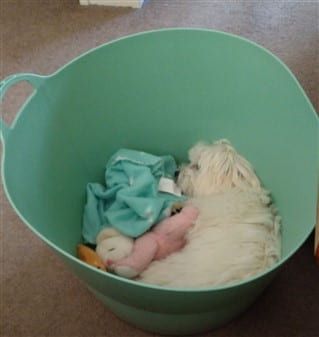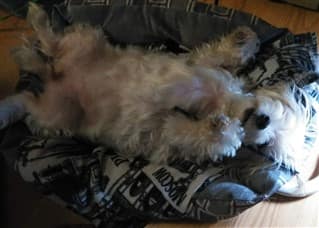Maltese Sleep Issues and Info
While sleep itself may at first seem like a rather straightforward thing, there are actually several components to a Maltese puppy or dog sleeping that bring up questions and concerns. This article will cover:
- Interesting facts about canine sleep
- Sleep requirements for Maltese at all life stages: newborn, puppy, adult, and senior
- Sleep problems and solutions
- When a Maltese sleeps too much
- Creating an ideal sleeping area
So, let’s dive in to the subject of sleep to make sure that your Maltese is meeting their requirements and getting quality sleep for daily rejuvenation and optimal physical and emotional health.
Please note:
PetMaltese is reader-supported. Some of the product suggestions on this page are affiliate links. As an Amazon Associate we earn from qualifying purchases. This is at no extra cost to you and helps us continue creating useful content.
Some Interesting Facts about Canine Sleep
- Studies show that dogs sleep and dream very similarly to humans, with the same type of sleep patterns.
- One phase of sleep that canines experience (like us) is REM (rapid eye movement) during which dreaming occurs. With REM there may also be increased rate of breathing, vocalizations, and muscle twitches.
- A number of studies suggest that small dogs dream more often than larger dogs (a new dream approximately every 10 minutes vs every 60 to 90 minutes); however, dreams tend to be shorter in length (1 to 2 minutes vs 10 or more minutes). It is also believed that puppies dream more often than adult dogs and it is theorized that this is because they have more new information and stimuli to process.
- Puppies and senior dogs tend to twitch more while sleeping. This is due to a part of the brainstem called the pons that regulates how large muscles are ‘turned off’ during sleep. The pons is underdeveloped for young pups and less efficient for senior dogs.
- Though it can only be speculation, it is strongly believed that dogs dream about recent events and frequent experiences, meaning that your Maltese most likely has dreams about you.
- Dogs can have good dream and bad dreams (aka nightmares) just like humans do. Anecdotal evidence shows that previously neglected or abused dogs have more nightmares than those without that sort of history.
- Canines need to sleep for the very same reasons that humans do: It allows the body to reset and restore cognitively and physically.
In regard to cognitive aspects, it allows the brain to sort and process all the tiny bits of information that were picked up since the last sleep episode and is when data is transferred from short to long-term memory.
And in regard to restoration, sleep is when the body repairs itself; this includes organs, muscles, tissues, and the immune system. So, if a Maltese does not receive regular quality sleep, this can greatly impact both their physical and emotional health.
Now that we know how important sleep in, let's look at some of the related problems that can occur.
Coco, at 15 weeks old (and 2.3 pounds),
photo courtesy of Krish Sharma, Rohit Sharma, and Anu Mohil
Sleep Requirements for Maltese at All Life Stages
Newborns
The newborn phase is a short one, lasting from Day 1 to 7 weeks old and there are lots of changes during this time, including how much sleeping will occur.
Young newborn Maltese pups from birth to 2 to 3 weeks old sleep approximately 22 hours a day; just about every moment not nursing is spent sleeping. Around the 3-week mark, pups will sleep 20 to 21 hours a day due to more time awake exploring their new world.
Puppies
Maltese puppies from 2 to 5 months old normally sleep 18 to 20 hours in a 24-hour cycle; this includes both nighttime sleep and naps taken during the day. How many naps are taken depends on how long the pup sleeps at night and the periods of stimulation and rest that are offered during the day, but in general puppies this age will take at least 2 to 3 daytime naps.
Older Maltese puppies from 6 to 11 months old sleep 14 to 16 hours in a 24-hour day and are working their way toward sleeping better and longer at night with fewer naps during the daytime.
Adults
Adult Maltese dogs from the age of 1 to 7 years old sleep approximately 12 to 14 hours in a 24-hour day. There is typically at least 1 daytime nap, but even 2 or 3 short naps is normal. Dogs that are under-stimulated and not often engaged in play tend to nap more frequently and/or longer than those that have interesting interactions.
Seniors
Senior Maltese dogs gradually start requiring more sleep and this need usually increases each year that they age. This is typically noticed by the time a Maltese reaches the 10-year mark. By the teens, older dogs may be sleeping several extra hours a day, in the 15 to 18 hour-a-day range.
In many cases, there is restless sleeping at night and more daytime naps. This sort of disrupted sleep is often linked to joint pain associated with arthritis that can interfere with an older dog’s ability to fall asleep or stay asleep. These challenges are discussed ahead under ‘Sleeping Problems and Solutions: Seniors’.
This little cutie pie fell asleep in a laundry hamper!
Pandora, at 6 months old, photo courtesy of Louise (from New Zealand)
Sleep Problems and Solutions: All Ages
There are a few common issues that can interfere with a Maltese’s ability to get a good night’s sleep. This includes trouble settling down at night, crying or whining at night, and waking up very early in the morning.
Fortunately, there are lots of things you can do to help your Maltese get the sleep they need.
1. Try to keep a schedule.
Though there can be some wiggle room, create a realistic schedule of the hours you wish for your Maltese to sleep at night. In most cases, this will closely align with when you wish to go to bed.
2. A lively exercise session 2 hours before bed.
Ideally, a Maltese should have several exercise sessions
per day. Walks are great since this allows a dog to release pent-up energy and engage their canine senses. Cardio exercise that is achieved when playing a rousing game like fetch is also fantastic. It is most conducive to sleep when this sort of exercise is just about 2 hours before bedtime.
3. Evening bathroom trip.
Bring your Maltese to their designated bathroom area 30 to 45 minutes before bed time. Never rush this; it’s recommended to allow at least 15 minutes of uninterrupted time. If your Maltese tends to wake up very early for bathroom needs, bring them outside just mere minutes before bedtime for one last attempt; be sure to keep this a very mellow event with no playing and very limited speaking.
4. Encourage a wind-down.
Just about 30 minutes before bedtime, create a relaxing atmosphere. Put a stop to any energized playtime with your Maltese, lower the volume on the TV, and dim the lights.
5. Designated sleeping area.
It can be very tempting to have your Maltese sleep in your bed with you and it’s true that this may help a pup doze off very quickly and have fewer wake-ups during the night. But you’ll be trading a long-term solution for a short-term fix and this typically leads to issues down the road. In many cases, a defined space (via a doggie playpen or gates) that holds a quality doggie bed is the foundation for this sort of sleeping area. More details are ahead under ‘Creating an ideal sleeping area’.
6. Comfort items.
New puppies that just left their mom and littermates may find comfort with something that has their scent on it (many breeders provide this when placing a pup in a new home). And for Maltese of all ages, having a companion toy can help them feel safe and secure enough to relax and drift off to sleep. More details are ahead under ‘Creating an ideal sleeping area’.
7. Make adjustments to meals and/or bedtime for early risers.
If your Maltese keeps waking up early in the morning before you’re ready to start the day, try feeding the last meal of the day 1-2 hours later or earlier. This can cause a dog’s next bowel movement to either occur earlier (before they go to sleep) or later than usual the next day.
8. Consider early morning noises. If your Maltese is waking up very early in the morning, another aspect to consider is that a certain noise may be disturbing them. Common pre-dawn elements include birds chirping and a neighbor’s car alarm beeping off and/or cars being started. If you suspect this may be the case, it can help to move your dog’s sleeping area to a quieter location or setup a white-noise machine to block out those sounds.
9. Limited interaction for whining if all needs are met.
It’s common for young pups to cry at night, especially during the first few weeks or months in a new house. This is also very common for older adopted dogs that have not yet adjusted to a new household.
With puppies, it’s usually best to wait a bit before rushing over. This gives the pup a chance to naturally fall back asleep and also opens up the opportunity for the pup to learn self-soothing.
If your Maltese is safe, warm, and fed, has access to their water and perhaps has a favorite toy or a comfort item, ignore the first 10 minutes of whining. If it continues, you can quietly go over for a quick check and offer a few pets while keeping lights dim. These checks should not be more than every 1 to 2 hours.
Whining at night usually sorts itself out over time (2 to 6 weeks) as a dog adjusts to their new environment.
10. React appropriately to possible bathroom needs. It is possible that a dog of any age may whine or bark at night due to bathroom needs; but it doesn’t happen as often as owners may think. Young pups usually do not understand enough to know to alert their humans and well-trained dogs typically fall into a schedule that limits middle-of-the-night urination or defecation.
This said, it is common for senior dogs to have weakening bladders and therefore the urge to urinate may wake them up at night. Urinary tract infections, bladder infections, canine diabetes and other health issues
can also cause increased urination. And gastrointestinal problems may lead to frequent bowel movements.
If you do suspect your Maltese is waking up for bathroom needs, bring them out with limited lights and no speaking other than to quietly say ‘good job’ once the deed is done.
Keep reading or jump down to ‘Creating an Ideal Sleeping Area’.
This sleeping beauty is Abby, photo courtesy of Sharon Leger
Sleep Problems and Solutions: Seniors
As dogs transition into the senior years, there is an increased need for sleep. Yet, senior dogs can have trouble falling asleep and staying asleep.
One of the top causes for this is osteoarthritis. A whopping 20% of all adult dogs have this painful joint disease. And it starts to develop much earlier than many owners expect; 65% of dogs age 7 and up have some level of arthritis and this jumps to 80% by the 8-year mark.
Common symptoms include stiffness, discomfort, and decrease mobility.
In addition to this, senior dogs also tend to have more nighttime muscle twitches which can cause sleep disturbances.
Let’s look at some additional tips can help seniors sleep better.
1. Vet checks.
First and foremost, trouble sleeping should not be brushed off as a ‘senior dog problem’. In regard to osteoarthritis, there are many treatment options including joint supplements like Pure Paw Nutrition Premium Hip and Joint Care , massage therapy, certain exercises, a wide range of prescribed medications such as NSAIDs, steroids, and analgesics, and alternative treatments including therapeutic laser and acupuncture.
, massage therapy, certain exercises, a wide range of prescribed medications such as NSAIDs, steroids, and analgesics, and alternative treatments including therapeutic laser and acupuncture.
Other sleep disturbances or insomnia problems may be treated with melatonin or other sleep aids.
2. A proper orthopedic bed with bolsters.
Maltese of any age can benefit from a supportive mattress, but this is especially vital for adults age 7 and up. And beds with firm bolsters that encourage a dog to curl up as opposed to fully stretching out can help limit muscle twitches. Look for a bed that has at least 2.5-inch memory foam and bolsters that leave easy access for entering and exiting the bed like the Friends Forever Memory Foam Prestige Edition Dog Bed . Finally, be sure that the bed is sized for your Maltese and not designed for a dog much smaller or larger.
. Finally, be sure that the bed is sized for your Maltese and not designed for a dog much smaller or larger.
Keep reading or jump down to ‘Creating an Ideal Sleeping Area’.
This amusing girl is Zoe, at 10 years old,
photo courtesy of Erica Rivera
When a Maltese Sleeps Too Much
If your Maltese just lies around all days and wants to do nothing but sleep, this is a huge red flag that something is wrong. Healthy and happy Maltese dogs are alert, playful, and active.
Acute or chronic lethargy, weakness, or increased sleep is often due to some sort of health issue. This can range from hypoglycemia to canine diabetes to a wide range of disease or illness associated with organ function, the immune system, or other serious issues. So, taking your Maltese in for a veterinary exam should always be the first step when working to resolve this sort of problem.
Another possible cause is decreased emotional health. Dogs that are chronically bored or lonely often sleep the day away. Try to fit in at least two 30-minute walks and more one-on-one play sessions. It can also help to include your dog in other tasks as often as possible, bringing them along to run errands or keeping them by your side if you are working in the yard, etc.
Newborns like this sweet 3-week-old Harlow here can not sleep too much!
Photo courtesy of Wendy Lewis
Creating an Ideal Sleeping Area
It is true that some dogs can take a snooze just about anywhere: On floors, up on their human’s furniture, under a table, in closets, or just about any place that they happen to be when feeling sleepy.
But there are several benefits when a dog has their own area. It gives a dog a ‘den’ that, due to canine instinct’, is associated with safety and security. This is always helpful for Maltese that have to spend some time home by themselves and/or have trouble relaxing at night. A defined space also limits bathroom accidents. And, for dogs that may otherwise resist it, it encourages a dog to sleep on their own dog bed.
So, let’s look at how to create this sort of area that your Maltese will look forward to retreating to when the day is winding down or they want to take a short nap.
#1 Choose a quiet area but not one that is isolated.
Avoid spots with lots of foot traffic or where people tend to gather around with lively conversations (near the front door, close to the kitchen table, etc.) but also not so far away from the family that a Maltese feels abandoned (in a bathroom, infrequently-used mud room, etc.). In most apartments and homes, a quiet corner in the living room or kitchen usually works well.
#2 Check for temperature fluctuations.
Small toy breeds like the Maltese can be sensitive to drafts or being too close to AC or heating vents. Don’t just guess about this, but get down at floor level and check for this.
#3 If there is a need, use a canine playpen or gates to create a defined area.
An indoor playpen like the IRIS 4-Panel Pet Playpen with a Door
 is ideal in many cases. It’s perfect when housebreaking, as a safe spot when a dog is home alone, and a way to keep a dog safe and on their bed at night if they would otherwise roam the house. Note that the Iris basic 4-panel model offers 9-square feet of space but if you decide that you want your little guy or gal to have more room, there are optional add-on panels.
is ideal in many cases. It’s perfect when housebreaking, as a safe spot when a dog is home alone, and a way to keep a dog safe and on their bed at night if they would otherwise roam the house. Note that the Iris basic 4-panel model offers 9-square feet of space but if you decide that you want your little guy or gal to have more room, there are optional add-on panels.
#4 Provide a quality bed.
It's important to provide a proper mattress for effective relief on pressure points and good support for the body. If not, there can be less-than-optimal rest and body restoration that is vital for tissue repair and daily upkeep from the previous day's wear and tear. In time, there can be issues with the joints (hips, knees, elbows) and/or back problems.
In addition, as we covered a bit earlier, dogs nearing the age of 7 can start to develop osteoarthritis and providing a quality memory foam bed is an important step in helping to delay that very painful disease.
While there are lots of designs for dog beds, it's recommended to stick with a minimum of 2.5 inches of solid memory foam, side (or rounded) bolsters, and a size that is appropriate for this small toy breed.
Aside from the previously mentioned Friends Forever bed, we also really like the JOYELF Memory Foam Dog Bed.
#5 Provide other care-based necessities.
The floor of the area can be lined with pee pads and water should be accessible at all times. You may also wish to keep a few favorite chew toys there as well.
#6 Offer comfort items, if needed.
This may include a soft baby blanket or a companion toy like the SmartPet Love Snuggle Puppy Behavioral Aid .
.
Other Helpful Articles:
When a Maltese Smells Bad
- Regardless of how a puppy or dog looks, there can be an odd odor. See the most common reasons and exact steps to have your Maltese smelling nice and clean again.
When a Maltese Chews at Their Paws
- Reasons for this include allergic reactions that cause itching, irritation from walking surfaces, stress, and habit. Learn how to respond and stop this behavior.
When a Maltese Eats Grass
- If your little guy or gal loves to munch on grass, see why this can be detrimental and ways you can stop this habit.
Vaccination Schedule for Maltese
- A summary of which shots are needed when. Includes both puppy vaccinations and adult boosters.

-min-450x169-1920w.jpg)





